By Ilma Hackett – Balnarring & District Historical Society
It is a small, unpretentious, weatherboard building standing back from the roadway on the wide corner block of land where Merricks Road meets the Bittern–Dromana Road. Motorists drive past, barely registering its presence. This is Fenton Hall, once the heart of the Merricks North community and, for many who grew up nearby, it still holds its soul.
A school needed
It began life as a school. In 1937 the Education Department had leased a vacant farmhouse, ‘Pembroke’, where Miss Beatrice Storer was employed to teach the fourteen school-age youngsters who lived in the area. Prior to that, children from the farms and orchards travelled several miles to the schools in Merricks, Red Hill or Balnarring, or they were taught at home. Now Merricks North State School No. 4552 had opened. However the accommodation was a temporary arrangement and the owner of ‘Pembroke’ did not wish to continue the lease. In the winter of 1938, families who lived in Merricks North met with the purpose of resolving the school problem.
The public meeting, chaired by local man, David Robb, took place at ‘Pembroke’. A letter had been received from the Education Department offering the sum of 60 pounds, the equivalent of five years rent, towards the building of a new school if the community could raise the remainder. Two councillors and the Shire Secretary attended the meeting and informed the gathering that a site of one and a half acres (0.6 hectares), the former junction of Merricks Road with Tubbarubba and Bittern-Dromana roads, was available.
The community pitches in
As a result of the meeting a committee of three (David Robb, James Fenton and Fred McIlroy) was formed to raise the necessary money. Work towards finalising the land transfer and planning the building went ahead. At a subsequent meeting, three weeks later, with the bulk of the subscriptions collected, a Committee of Management consisting of seven members was elected and work began in earnest. First the land was cleared of timber by the Council’s sustenance work group and towards the end of July the committee met on site to determine where the building would be positioned. Then began a series of weekly working bees to grub stumps, haul timber and level the ground using equipment pulled by draught horses.
When all was ready work started on erecting a wooden building 24 feet by 24 feet (7.3 x 7.3 metres) under the guidance of Jack Burton, a local builder who owned a small orchard over the road. Labour was never in short supply. Local residents turned out in force. While the men did the heavy work, the women kept the billy boiling and provided refreshments. Children scrambled over the mounds of earth and stacks of timber about the site, turning it into an adventure playground. Work continued every Saturday and by 22 October, 1938 all was ready for the official opening, barely three months after the foundations were put in place.
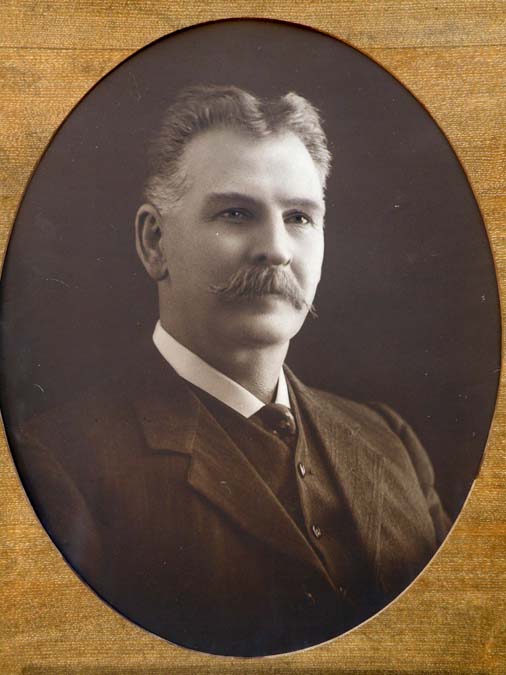
James Fenton M.H.R.
James Fenton was enthusiastic about the school from the start. A former parliamentarian, his home was in Merricks North and in 1938 he had been retired for two years. Fenton had entered politics in 1910 when elected to the House of Representatives after winning the seat of Maribyrnong. He went on to hold this seat for the next twenty-four years. While serving under Scullin, he deputised for the Prime Minister when Scullin was overseas. However disagreement over policy during the Great Depression led to Fenton supporting Joseph Lyons when Lyons split from the Labor Party and formed the United Australia Party. After losing his seat in 1934 Fenton became Director of the Commonwealth Oil Refineries. Known as ‘Jim’ to his neighbours Fenton lived with his family at ‘Carinya’, on the corner of Tubbarubba Road and One Chain Road in Merricks North, a property he had owned since 1918. He took a keen and active interest in local affairs and it was through his influence that Merricks North had its own Post Office instead of using the Merricks Post Office at Weston’s store.
Merricks North State School is officially opened
Fenton had invited the Prime Minister, Joseph Lyons, to open the new school but Lyons was unable to attend. Instead, the Assistant Minister for Commerce, Senator Allan McDonald officiated. Also present were Mr Curtain (MLA), Mr Gartside (MLA), the Hon. James Fenton, Mr Rudd the Shire President, and the Chief Inspector of Primary Schools, Mr Leach. Senator McDonald admitted he had never heard of Merricks North until Mr Lyons had asked him to represent him but he commented that he was “astounded by its beauty and considered it had a very bright future.” (Argus, Monday, 24th October, 1938). It was a gala occasion, a major social event, for the whole community which turned out in force.
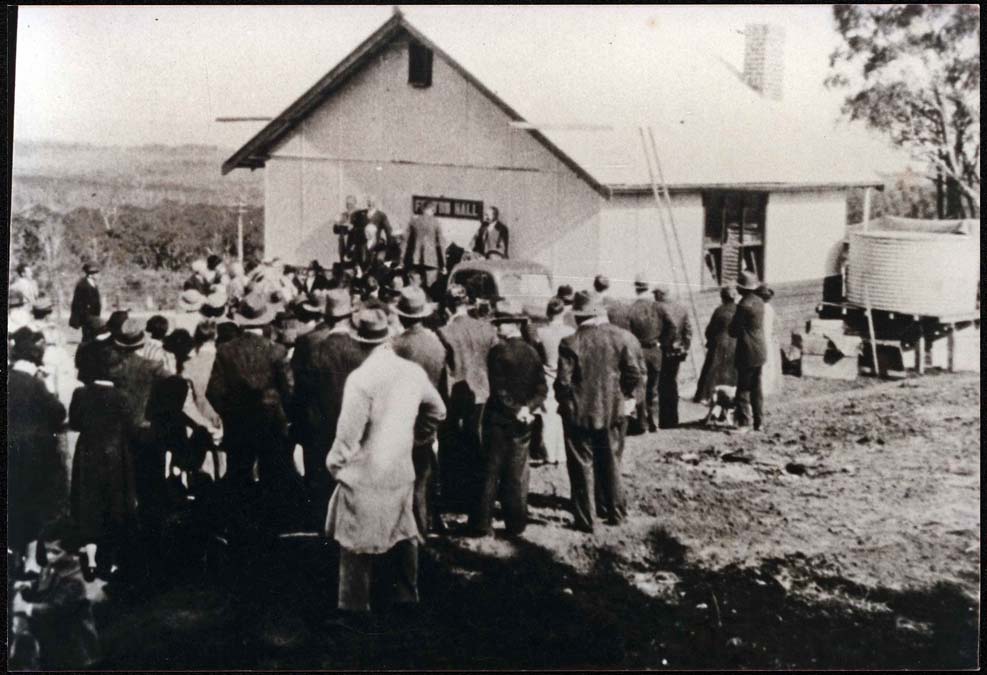
Ray Murphy was appointed teacher. His pupils ranged from Grades 1 to 8 and they sat in desks of varying size. The teacher had a table and chair at the front of the room. The blackboard was fixed to the back (south) wall of the school-room, next to the open fireplace. It was a back-to-back fireplace with the one in the supper room which was on the south side of the school-room. The supper room measured 12 feet by 24 feet (3.6 x 6.5 m) and was built by Jack Burton. This had been added soon after the school was officially opened as the building was also to serve as a community hall. It was fitting that the hall should carry the name of James Fenton who had been instrumental in its establishment.
A working bee constructed a shelter shed (a roofed structure with three walls and an earthen floor) in the grounds for the children to use. The earliest toilets were pans in little wooden shelters tucked away near the edge of the bush. These had to be emptied by the older school boys. A hole was dug and the contents emptied into the hole and buried. In 1941 the Shire was asked to have the Sanitary Contractor call to empty the pans at the hall.
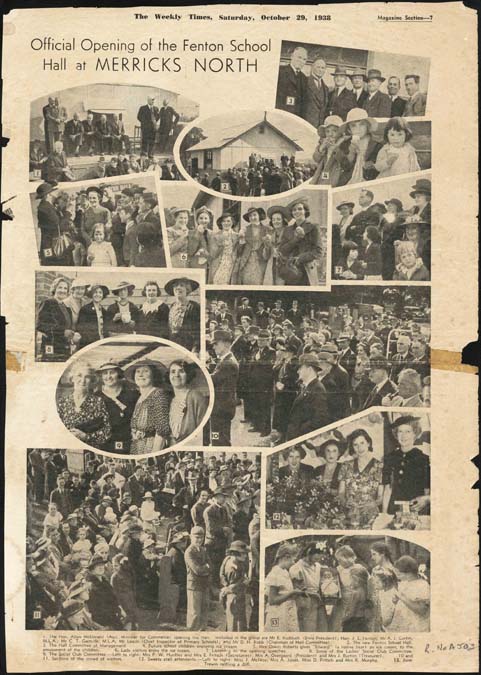
Children entered the building by way of the door into the supper room where bags were left before lessons began for the day. Roger Carr recalled the open classroom where “Biggies could help the Littlies and you were always inclined to work one or two years ahead of your year as your interest was taken by another’s work.” Mary Karney (then a pig-tailed Mary Robb) remembered their Young Farmers Club when they planted orchard trees in a plot facing Merricks Road. “Orchardist fathers gave us lessons on upkeep, pruning etc.”
The school year always ended with a concert given by the pupils and the highlight at the end of the proceedings was the arrival of Santa Claus to the skirl of bagpipes played by David Robb. Gifts were then distributed and a dance followed.
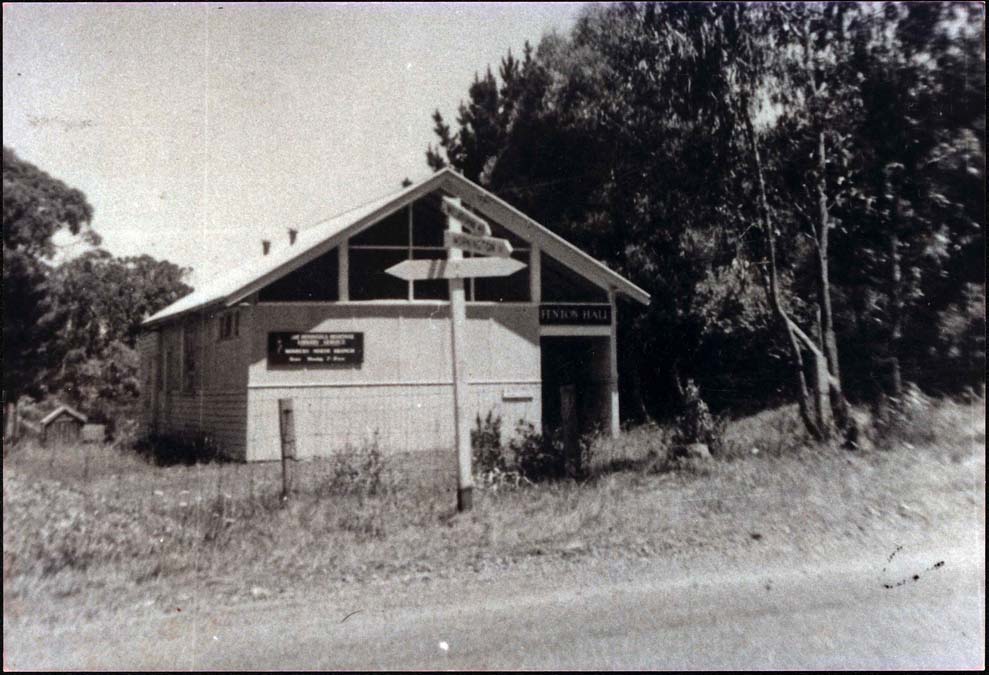
A community centre
A small, rather tinny piano had been donated soon after the hall opened and each Friday, when classes ended for the week, the children carried the desks out to the shelter shed. This was in readiness for Saturday when ballroom dancing lessons were given to the older boys and girls by a husband and wife team. Mr Watts explained and demonstrated the steps while his wife played the music. Old-time dances taught included the Pride of Erin, Parma Waltz and Barn Dance. Not the Fox Trot; it was considered too modern!
As a community hall it could be hired for various purposes. Two residents who lived nearby held keys and they arranged bookings. On a Sunday Presbyterian church services were held, with the group paying one shilling for each service. In 1940 electricity came to the area and the hall was connected.
World War II and the years following
The war years brought changes to the district. During 1941 and 1942, after Japan entered the war, there were a number of troops camped throughout the district and dances were frequently held for their entertainment. The piano and a couple of violins supplied the music and partners were often school girls but there was always an excellent supper. The Committee of Management decided that any function held to raise money for patriotic purposes would be free of charge.
The hall became a First Aid post and the centre for the Red Cross Air Raid Precautions Group. The signals, as remembered by Mary Karney, were:
Red – alert;
Yellow – take precautionary measures;
Black – prepare for air raid;
White – cancel;
Green – all clear.
Windows were “blacked out’ in accordance with regulations and some doors were painted black.
Working bees were held periodically to beautify the surrounds by planting trees and shrubs while money needed for maintenance work and repairs was raised by holding dances and euchre parties in the hall. Whole families attended the dances. The ladies cleaned the hall in the evening and the floor was scattered with sawdust and kerosene or candle shavings to give it a gloss. Children helped by taking running slides across the floor in their socks.

A Younger Set formed in 1944 but numbers fell away. Then three years later, in 1947, Garry Downward and Jim Martin started up the Merricks North Youth Group which met every Tuesday. Later a new group of young people met socially on Friday evenings.
Tennis was popular and a club was formed. Two courts were planned on fairly level land behind the hall where the old road had been. One was built but the second didn’t eventuate. Interest in tennis waned and the existing court fell into disrepair.
In February 1949 the Merricks North Progress Association formed with Bill Stone as its president. Its meeting place was Fenton Hall. In May the local branch of the Liberal Party also began holding meetings there. That same year a request came to the Hall Committee from the Hastings RSL asking it to refuse use of the hall for any Communist Party meeting.
At the end of the decade a fund was started to raise £135 to buy a better piano. This started with a social. On the evening Mrs Watts provided the music, the floor was prepared for dancing and ladies attending were asked to bring a ‘basket supper’. The door fee was two shillings. As well as dancing, card games in the form of progressive euchre were played in the supper room. Picture shows followed by a supper were popular but the fund grew slowly. In 1954 the old piano was sold for six pounds two shillings. The total amount still fell a long way short of the amount needed. Ted Fritsch stepped in and offered to pay for the piano. He was given a cheque for the amount of money sitting in the fund but he never cashed it.
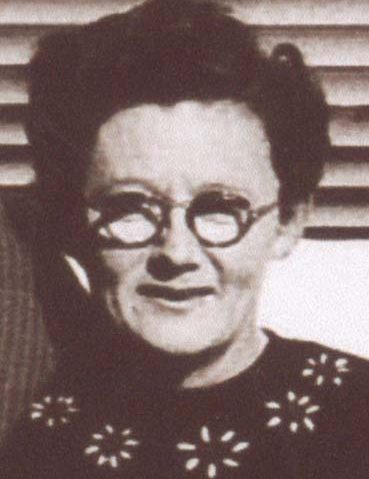
The school closes
The school had a succession of teachers. Ellen Harding replaced Mr Murphy. She boarded with the Burton family who lived opposite Fenton Hall. The number of pupils remained small and boys and girls often played together in the school-ground. ‘Cowboys and Injuns’, various ball games, marbles and foot races were popular. Mr Laurie Cooper succeeded Miss Harding as teacher and when he joined the Forces in 1942 Mrs Vera Francis took his place. According to Roger Carr she drove an “old black oblong of a car”, collecting children along her route.
Although the school was small it took part in the first combined Peninsula School Athletics Carnival held at Hastings in 1950. As one pupil recalls, “To great excitement, jubilation and euphoria our tunnel ball team, which included the entire school enrolment over third grade, took home the winner’s flag. It was proudly displayed for the rest of the year.” When Mrs Francis left, after eight years at the school and with closure pending the following year, she was given a sincere and emotional farewell from not just the school community. Merricks North State School closed its doors for the final time at the end of the 1950 school year, as did most of the other small schools of the district. From 1951 children were taken by bus to the new consolidated school at Red Hill.
The community’s hub
The hall no longer had the guaranteed income from the rental of the premises by the Education Department but throughout the 1950s Fenton Hall remained a hub for the community.
It became the local Baby Health Centre in 1951 where mothers could bring their infants to be weighed and checked by a visiting mothercraft nurse and where new mothers could socialise with other mothers. Five years later the Baby Health Centre asked the Committee to upgrade the hall to comply with Health Department regulations. The Flinders Shire Council helped with the cost, matching pound for pound to a limit of £100. Once again local people helped by donating necessary items and volunteering their labour to bring the building up to standard. The hall continued to echo with the voices of children when a pre-school was established. Children not yet of school age came to learn and play with each other in readiness for ‘big’ school.
Then in 1952 Fenton Hall became a polling station. Prior to that people registered their vote at the general store at Merricks. On election days for many years the hall became a hive of political activity. During the 1950’s it also became home to a lending library for the people of Merricks North. The Flinders Shire Council set up a number of depots across the peninsula where people could borrow books. Periodically the central library at Rosebud sent out a new supply of books to change over the reading stock. The hall was fitted with bookshelves made by Horace Reid.
With Fenton Hall on one side of the Bittern–Dromana Road and the post office building on the other, until its closure in1966, that particular corner continued to be a natural meeting place for the people who lived in the neighbourhood. The junction was a stopping place for the school buses where children were picked up in the morning and dropped off at the end of the day and a bus shelter was erected in front of the hall in 1954.
A change of direction
In 1955 the Progress Association took over the responsibility from the Fenton Hall Committee which remained as a sub-committee of the Association, attending to its maintenance and insurance matters, while the Progress Association pushed for matters that affected the whole community. Some were successful, some not. A public telephone box never materialised, nor did an official rubbish tip for the area but road maintenance and improvements met with some success after constant complaints.
An extension to the hall was made to the north side of the building in 1959. Measuring 15 feet by 24 feet (4.5 x 6.5 m) it included a covered entrance. The same year a barbecue fireplace was built in the grounds. A much needed new toilet block was built in 1968 when Garry Downward, now a local councillor, pressed to have the antiquated toilets replaced. These had been condemned by the Department of Public Health.
By the 1970’s many of the members of the original Progress Association had either left the district or died and they were replaced by new residents whose interest in the community was equally as focused and keen. The new organisation called itself the Merricks/Merricks North Progress Association and Fenton Hall Committee of Management. It combined the interests and duties of both of the former groups.
Ballet School
The 1970’s brought a new activity to the hall which was to last for almost two decades. It again became a school but this time a ballet school. Newcomer to the district, Clare Major, was a graduate of the London College of Dance and Drama. She rented the hall for a dance school. Former pupil Sarah Hale recalls, “Classes were held on Saturday mornings and after school most afternoons of the week… I have many a wonderful memory both outside the hall and in the back kitchen, being told to ‘ssshhh’ before the class actually started.” Clare, “a wonderful teacher”, also prepared her students for the annual British RAD ballet exams and entered them in eisteddfod competitions around Melbourne. End-of- year concerts were a magical highlight for the young dancers. Classes continued until Clare retired in 1988 and moved from the district.

More recent activities
Enthusiasts of varied activities have used the hall as their centre. It has echoed to the rhythm of tap dancing classes and line dancing which enjoyed popularity for a time. It has housed a group with spinning wheels, table tennis players and a band held practices there. Husband and wife, Peter and Nola Coulthurst, who lived nearby, were treasurer and secretary of the committee for many years and bookings for the hall were made through them. Their house was a handy pick-up point for the key. They adopted a caretaker role for the hall for about twenty-five years. The Committee of Management working with Hastings Shire made major updates and improvements to the building while minor problems were often dealt with by someone local.
The hall saw many a private party in celebration of a special event as it offered both indoor and outdoor facilities. The Farmers Association and environmental groups made it their headquarters and the local CFA held meetings there. Rental fees were kept low for local groups.
For a number of years a barbecue was held on Easter Sunday for local residents – a ‘Back to Merricks North Day’ – when people turned up from around the state to renew old ties. Many had gone to school at the hall. A Gala Day known as a Gathering was introduced in 1993 where residents could come together, enjoy a barbecue lunch, meet new people and reminisce with old friends. It remained a very popular event until just a few years ago.
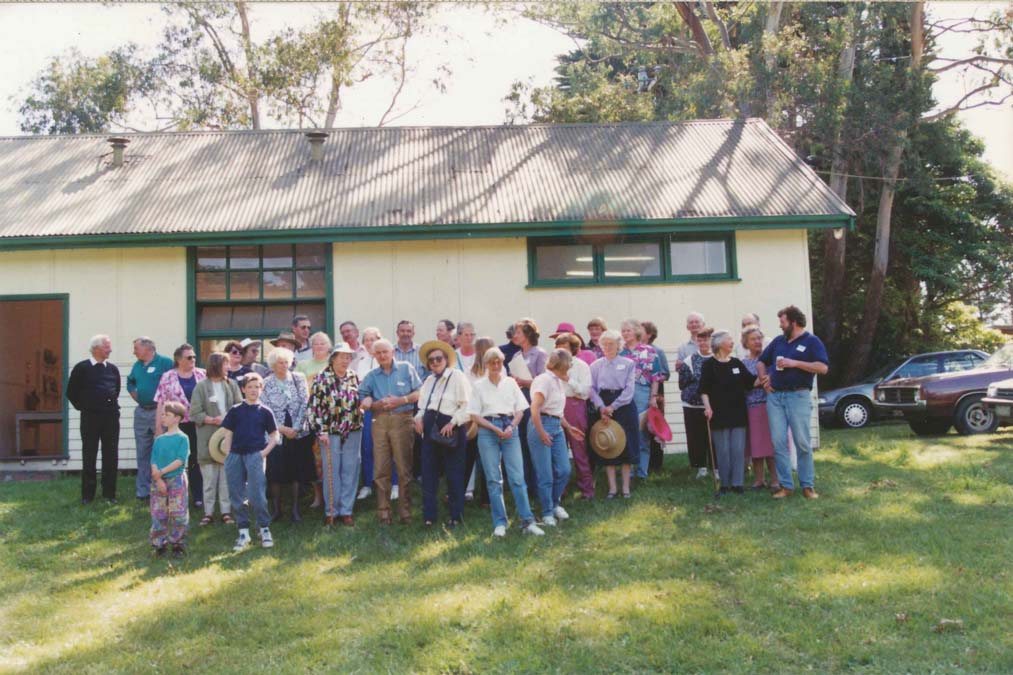
Winds of change
The local committee handled all matters relating to the hall until 1994 when the shires of the Peninsula were amalgamated to form the one Mornington Peninsula Shire run initially by state government-appointed commissioners. Changes were introduced and the local Committee of Management was replaced by contractors. The community was no longer responsible for looking after its hall. Gaining access to the hall became more difficult when the key was no longer held locally; there was more ‘red tape’ to negotiate. Use of the hall as a public meeting place gradually fell away.
There has been social change too, particularly during this century. People are wealthier and many no longer have a rural background. For many newcomers their Merricks North property is a weekend and holiday retreat. Interests lie elsewhere and with the improvements in transport and communication horizons are broader. The small hall at Merricks North is no longer seen as a neighbourhood centre.
Today the hall is unused. Long strands of bark, from the huge gum tree overshadowing the building, accumulate on its roof. Dead leaves choke the gutters and have been blown into holes in the weatherboards at ground level. The windows are dusty. Spiders weave intricate webs in corners. The toilet block is closed off – an ‘out of order’ sign bars admittance. Yet the hall has special meaning to many people associated with Merricks North. A local Friends group has been organised and is working with the Shire to see how the old building can be given new life. The Shire is currently undertaking an extensive survey to identify the hall’s structural problems and its heritage worth is under review. Fenton Hall sits waiting. Its future is still uncertain but not without promise.
References:
The Story of Fenton Hall by Mary Karney
Snippets, the news sheet of Balnarring & District Historical Society;
Contemporary newspapers
Photographs:
From the B.D.H.S. collection
For further information contact: savefentonhall@gmail.com






